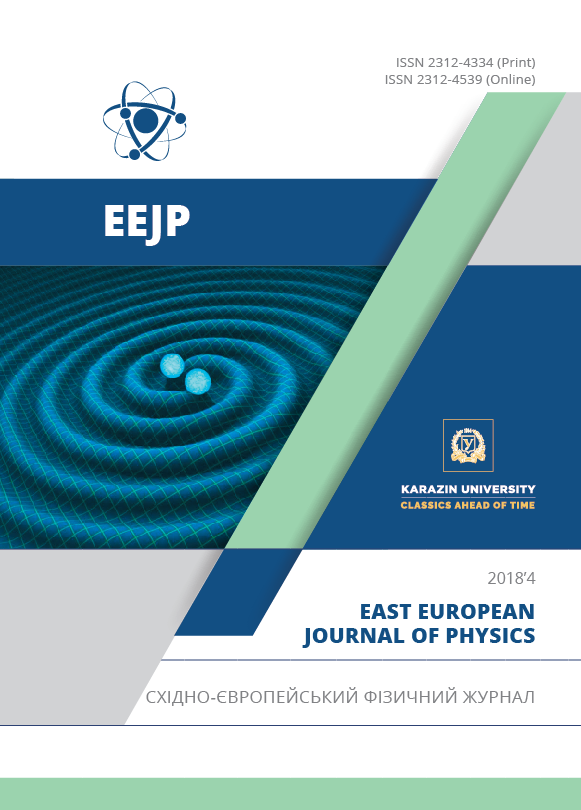Супрамолекулярний дизайн карбонів для накопичувачів електричної енергії з реактансно-сенсорною функціональною гібридністю
Анотація
Метою даної роботи є розширення класу накопичувачів електричної енергії з неспряженою функціональною гібридністю. В якості вихідної речовини для досліджень використано циклодекстрини β- та γ- модифікацій, які містять внутрімолекулярні пустоти, які здатні акомодувати гостьові компоненти шляхом молекулярного розпізнавання за принципом “замок- ключ”. Для досліджень отриманих карбонових структур використали методи прецизійної порометрії та імпедансної спектроскопії, проведено електрохімічні та магнітні вимірювання. Дані прецизійної порометрії засвідчили про бімодальну пористу структуру синтезованих карбонізатів. Загальна питома площа активної поверхні β-циклодекстринового карбонізату становила порядка 72 м2/г. Після KOH-модифікації питома ємність для β-циклодекстринового карбонізату становила 158 Ф/г, а у від’ємній області потенціалів – 203 Ф/г. Для γ-циклодекстринового карбону остання величина становила – 162 Ф/г. Використовуючи здатність β-циклодекстрину до молекулярного розпізнавання фероцену (FС) цей кавітат піддано активаційній карбонізації за тими ж режимами, що і β-циклодекстрин. Питома ємність отриманого карбонізату комплексу β-CD<FС> після KОН-модифікації становила 110 Ф/г. Для кавітатного карбону, синтезованого з γ-CD<FС> питома ємність впала у два рази. Дослідження β-циклодекстрин комплексів включень “господар-гість” з молекулярним йодом, вказали на незначне зростання ємності. Проте їх межа з 30 %-водним розчином електроліту проявила високу фоточутливість. При освітленні інтегральним і монохроматичним світлом від світлодіодів однакової інтенсивності питома ємність кавітатного карбону без КОН-модифікації зросла в 4 рази. Магнітні дослідження синтезованих карбонів показали, що усі вони проявляють феромагнітні властивості. Вимірювання комірок симетричної конфігурації з електродами на основі карбонів, синтезованих з γ-CD та γ-CD<FС> за нормальних умов та в постійному магнітному полі показали, що їх ємність практично не міняється, зате суттєво змінюються їх реактансні параметри. Суперконденсатори на основі цих карбонів можуть служити давачами слабкого магнітного поля за кімнатних температур, формуючи новий клас пристроїв – магнетоваріоністорів.
Завантаження
Посилання
B.E. Conway, Electrochemical Supercapacitors, (Plenum Publishing, New York, 1999), p. 698.
J.Р. Zheng, in: Proceedings of the 14th international seminar on double layer capacitors and hybrid energy storage devices, (Deerfield Beach, Florida, USA, 2004), pp. 142-154.
J.P. Zheng, T.R. Jow, J. Electrochem. Soc. 142(1), L6-L8 (1995).
D.A. McKeown, P.L. Hagans, L.P.L. Carette, A.E. Russell, K.E. Swider and D.R. Rolison, J. Phys. Chem. B. 103(23), 4825-4832 (1999).
B.E. Conway, H.A. Andreas, W.G. Pell in: Proceedings of the 14th international seminar on double layer capacitors and hybrid energy storage devices, (Deerfield Beach, Florida, USA, 2004), pp. 155-176.
B.P. Bakhmatyuk, B.Ya. Venhryn, I.I. Grygorchak, Micov M.M. and Yu.O. Kulyk, Electrochimica Acta, 52, 6604-6610 (2007).
B.Ya. Venhryn, Z.A. Stotsko, I.I. Grygorchak, B.P. Bakhmatyuk and S.I. Mudry, Ultrasonic Sonochemistry, 20, 1302-1307 (2013).
B.Ya. Venhryn, Z.A. Stotsko, I.I. Grygorchak, S.I. Mudry and O.V. Balaban, Archives of Materials Science and Engineering. 52, 18-22 (2011).
K.D. Tovstjuk, I.I. Grigortchak, Z.D. Kovalyuk, I.D. Kozmik, V.V. Netyaga and B.P. Bahmatyuk, Int. Appl. No PST/US92/ 09245 (13 May, 1993).
J.-M. Len, Супрамолекулярная химия. Концепции и перспективы. [Supramolecular chemistry. Concepts and perspectives], (Novosibirsk, Science, 1998), p. 333. (in Russian)
D.V. Steed, J.L. Etwood, Супрамолекулярная химия. В двух томах. [Supramolecular chemistry. In two volumes], (Moscow: Akademkniga, 2007). Vol. 1. – p. 480, Vol. 2. – p. 416, (in Russian)
Z.B. Stoynov, B.M. Grafov, B. Savova-Stoynov and V.V. Elkin, Электрохимический импеданс. [Electrochemical impedance], (Moscow, Science, 1991), p. 336. (in Russian)
E. Barsoukov, J.R. Macdonald, Impedance spectroscopy. Theory, experiment and application. (Canada, Wiley interscience, 2005), p. 585.
A.I. Kondyr, A.K. Borysyuk, I.P. Pazdrii and S.G. Shvachko, Vibration in engineering and technology. 34(2), 41-43 (2004). (in Ukrainian)
H.C. Wang, B.L. Li, J.T. Li, B. Zhang and Z.X. Wan, Applied Surface Science. 257, 4325-4330 (2011).
G. Gryglewicz, J. Machnikowski, E. Lorenc-Grabowska, G. Lota and E. Frackowiak, Electrochimica Acta. 50(5), 1197-1206 (2005).
A. Harada, S. Takahashi, J. Chem. Soc. Chem. Commun. 10, 645-646 (1984).
A. Harada, K. Saeki and S. Takahashi, Organometallics. 8, 730-733 (1989).
M.O. Polumbrik, Ye.O. Kotlyar, H.V. Omelchenko, M.M. Polumbrik and V.M. Pasichny, Food Science and Technology. 10 (3), 45-49 (2016). (in Ukrainian)
I.I. Grygorchak, A.K. Borysyuk, R.Ya. Shvets, F.O. Ivashchyshyn, N.T. Pokladok, V.I. Baluk, Yu.O. Kulyk, B.I. Rachiy, R.P. Lisovski and Yu.I. Sementsov, Physical surface engineering. 12(3), 412-427 (2014). (in Ukrainian)
T.L. Makarova, Semiconductors. 38(6), 615-638 (2004). (in Russian)
Цитування
IMPLEMENTATION OF THE EQUIVALENT CIRCUIT METHOD IN INSTRUMENTAL DIGITAL DIDACTICS
Атамась Артем Іванович, Сліпухіна Ірина Андріївна, Чернецький Ігор Станіславович & Шиховцев Юрій Сергійович (2021) Information Technologies and Learning Tools
Crossref
Автори, які публікуються у цьому журналі, погоджуються з наступними умовами:
- Автори залишають за собою право на авторство своєї роботи та передають журналу право першої публікації цієї роботи на умовах ліцензії Creative Commons Attribution License, котра дозволяє іншим особам вільно розповсюджувати опубліковану роботу з обов'язковим посиланням на авторів оригінальної роботи та першу публікацію роботи у цьому журналі.
- Автори мають право укладати самостійні додаткові угоди щодо неексклюзивного розповсюдження роботи у тому вигляді, в якому вона була опублікована цим журналом (наприклад, розміщувати роботу в електронному сховищі установи або публікувати у складі монографії), за умови збереження посилання на першу публікацію роботи у цьому журналі.
- Політика журналу дозволяє і заохочує розміщення авторами в мережі Інтернет (наприклад, у сховищах установ або на особистих веб-сайтах) рукопису роботи, як до подання цього рукопису до редакції, так і під час його редакційного опрацювання, оскільки це сприяє виникненню продуктивної наукової дискусії та позитивно позначається на оперативності та динаміці цитування опублікованої роботи (див. The Effect of Open Access).








